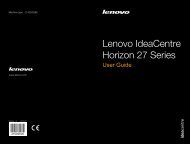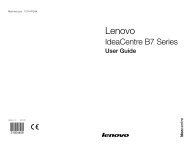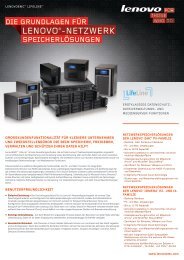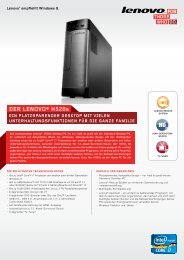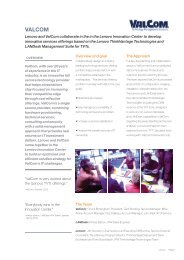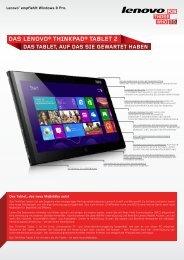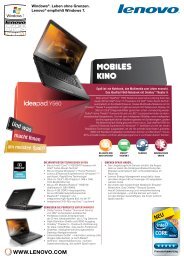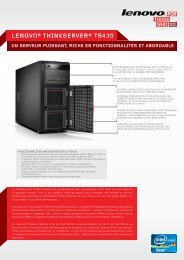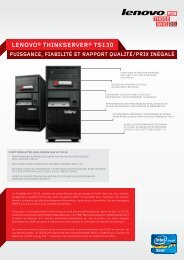U510 User Guide - Lenovo
U510 User Guide - Lenovo
U510 User Guide - Lenovo
You also want an ePaper? Increase the reach of your titles
YUMPU automatically turns print PDFs into web optimized ePapers that Google loves.
<strong>Lenovo</strong> IdeaPad<br />
<strong>U510</strong><br />
<strong>User</strong> <strong>Guide</strong> V1.0<br />
Read the safety notices and important tips in the<br />
included manuals before using your computer.
•<br />
•<br />
•<br />
•<br />
•<br />
Note<br />
Before using the product, be sure to read <strong>Lenovo</strong> Safety and General<br />
Information <strong>Guide</strong> first.<br />
Some instructions in this guide may assume that you are using<br />
Windows ® 8. If you are using other Windows operating system, some<br />
operations may be slightly different. If you are using other operating<br />
systems, some operations may not apply to you.<br />
The features described in this guide are common to most models.<br />
Some features may not be available on your computer and/or your<br />
computer may include features that are not described in this user<br />
guide.<br />
The illustrations in this manual may differ from the actual product.<br />
In this case, refer to the actual product.<br />
Regulatory Notice<br />
To refer to it, go to http://support.lenovo.com and click <strong>User</strong> guides<br />
and manuals.<br />
First Edition (July 2012)<br />
© Copyright <strong>Lenovo</strong> 2012.<br />
LIMITED AND RESTRICTED RIGHTS NOTICE: If data or software is delivered pursuant a General<br />
Services Administration “GSA” contract, use, reproduction, or disclosure is subject to restrictions set<br />
forth in Contract No. GS-35F-05925.
Contents<br />
Chapter 1. Getting to know your computer ..........................................1<br />
Top view.......................................................................................................................1<br />
Left-side view ..............................................................................................................6<br />
Right-side view............................................................................................................9<br />
Front view ..................................................................................................................11<br />
Bottom view ...............................................................................................................12<br />
Chapter 2. Starting to use Windows 8 ................................................13<br />
Configuring the operating system for the first time ............................................13<br />
Operating system interfaces ....................................................................................13<br />
The charms .................................................................................................................14<br />
Putting the computer to sleep or shutting it down ..............................................16<br />
Connecting to wireless LAN ...................................................................................18<br />
Help and support ......................................................................................................19<br />
Chapter 3. <strong>Lenovo</strong> OneKey Recovery system ...................................20<br />
Chapter 4. Troubleshooting .................................................................22<br />
Frequently asked questions .....................................................................................22<br />
Troubleshooting ........................................................................................................25<br />
Trademarks............................................................................................30<br />
i
Chapter 1. Getting to know your computer<br />
Top view - - - - - - - - - - - - - - - - - - - - - - - - - - - - - - - - - - - - - - - - - - - - - - - - - - - - - - - - - - - - - - - - - - - - - - - - - - - - - - - - - - - - - - - - - - - - - - - - - - -<br />
b<br />
c<br />
d<br />
e<br />
f<br />
Note: The dashed areas indicate parts that are not visible externally.<br />
<br />
Attention:<br />
• Do NOT open the display panel beyond 130 degrees. When closing the display panel, be<br />
careful not to leave pens or any other objects in between the display panel and the<br />
keyboard. Otherwise, the display panel may be damaged.<br />
a<br />
g<br />
h<br />
i<br />
1
Chapter 1. Getting to know your computer<br />
2<br />
a<br />
b<br />
c<br />
d<br />
e<br />
f<br />
g<br />
h<br />
i<br />
Integrated Use the camera for video communication.<br />
camera<br />
Computer display The LCD display with LED backlight provides brilliant<br />
visual output.<br />
Wireless LAN<br />
antennas<br />
Connect to the wireless LAN adapter to receive and send<br />
wireless radio.<br />
Power button Press this button to turn on the computer.<br />
Caps lock<br />
indicator<br />
Touchpad The touchpad functions as a conventional mouse.<br />
Note:You can enable/disable the touchpad by pressing F6 ( )<br />
Speakers Provide audio output.<br />
Number lock<br />
indicator<br />
Touchpad<br />
buttons<br />
The functions of the left/right side correspond to that of<br />
the left/right mouse button on a conventional mouse.
Keyboard function keys<br />
Chapter 1. Getting to know your computer<br />
By pressing the appropriate function keys, you can change system settings<br />
instantly. To use this function, press and hold Fn a,<br />
then press one of the<br />
function keys b.<br />
a b<br />
The following describes the features of each function key.<br />
Fn + Home: Activate the pause function.<br />
Fn + End: Activate the break function.<br />
Fn + PgUp: Enable/disable the scroll lock.<br />
Fn + PgDn: Activate the system request function.<br />
Fn + Space<br />
(on select models):<br />
b<br />
Turn on/off the keyboard backlight.<br />
3
Chapter 1. Getting to know your computer<br />
Hotkeys<br />
4<br />
Using hotkeys<br />
You can access certain system settings quickly by pressing the appropriate<br />
function keys.<br />
By pressing the appropriate hotkey, you can change system settings instantly.<br />
The following describes the function of each hotkey.<br />
Enables/disables airplane<br />
: Mutes/unmutes the sound. :<br />
mode.<br />
: Decreases the volume level. :<br />
: Increases the volume level. :<br />
: Closes the currently active<br />
: Refreshes the desktop or the<br />
: Enables/disables the<br />
window.<br />
currently active window.<br />
touchpad.<br />
:<br />
: Decreases display bright-<br />
Displays all currently open<br />
apps.<br />
Turn on/off the backlight of<br />
the LCD screen.<br />
Opens the interface for the<br />
display device switch to<br />
select this notebook or an<br />
external display.<br />
ness.<br />
: Increases display brightness.
Setting hotkey mode<br />
Chapter 1. Getting to know your computer<br />
By default, the hotkey functions are accessible by pressing the appropriate<br />
hotkey. However, you can disable the hotkey mode in the BIOS setup utility.<br />
To disable the hotkey mode:<br />
1 Shut down the computer.<br />
2 Press the Novo button and then select BIOS Setup.<br />
3 In the BIOS setup utility, open the Configuration menu, and change the<br />
setting of HotKey Mode from Enabled to Disabled.<br />
4 Open the Exit menu, and select Exit Saving Changes.<br />
Note: When hotkey mode is disabled, press the Fn key and the appropriate hotkey to access<br />
the corresponding hotkey function.<br />
5
Chapter 1. Getting to know your computer<br />
6<br />
a<br />
b<br />
c<br />
d<br />
e<br />
f<br />
g<br />
Left-side view - - - - - - - - - - - - - - - - - - - - - - - - - - - - - - - - - - - - - - - - - - - - - - - - - - - - - - - - - - - - - - - - - - - - - - - - - - - - - - - - - - - - - -<br />
a b c d e f g h<br />
Novo button When the computer is off, press this button to open Novo<br />
button menu. From the Novo button menu, start the<br />
<strong>Lenovo</strong> OneKey Recovery system or the BIOS setup<br />
utility, or enter the boot menu.<br />
Note: For details, see “Chapter 3. <strong>Lenovo</strong> OneKey Recovery system” on page 20.<br />
Ventilation slots Dissipate internal heat.<br />
Note: Make sure that none of the ventilation slots are blocked or else overheating of the<br />
computer may occur.<br />
RJ-45 port Connects the computer to an Ethernet network.<br />
MINI VGA Connects to external display devices.<br />
HDMI port Connects to devices with HDMI input such as a TV or a<br />
display.<br />
USB 3.0 port Connects to USB devices.<br />
In BIOS Setup Utility, if Always on USB is set to<br />
Enabled, when your computer is powered off, the port<br />
can charge most currently sold external USB devices. You<br />
can set USB discharge until the remaining battery level<br />
to 30%, 40% or 50%.<br />
Note:<br />
For details, see “Connecting USB devices” on page 8.<br />
When this setting is enabled, battery usage time of the computer will become shorter.<br />
Combo audio<br />
jack<br />
Connects to headphones or headsets.
h<br />
Chapter 1. Getting to know your computer<br />
Note:<br />
The combo audio jack does not support conventional microphones.<br />
The recording function may not be supported if third-party headphones or headsets are<br />
connected, due to different industry standards.<br />
Built-in<br />
microphone<br />
Captures sound which can be used for video<br />
conferencing, voice narration, or audio recording.<br />
7
Chapter 1. Getting to know your computer<br />
Connecting USB devices<br />
8<br />
Your computer comes with three USB ports compatible with USB devices.<br />
The first time you plug a USB device into a particular USB port on your<br />
computer, Windows automatically installs a driver for that device. After the<br />
driver has been installed, you can disconnect and reconnect the device<br />
without performing any additional steps.<br />
Note: Typically, Windows detects a new device after connecting it, and then installs the<br />
driver automatically. However, some devices may require you to install the driver<br />
before connecting. Check the documentation provided by the device’s manufacturer<br />
before connecting the device.<br />
Before disconnecting a USB storage device, make sure your computer has<br />
finished transferring data by that device. Click the Safely Remove Hardware<br />
and Eject Media icon in the notification area of Windows to remove the<br />
device before disconnecting.<br />
Note: If your USB device uses a power cord, connect the device to a power source before<br />
connecting it. Otherwise, the device may not be recognized.
a<br />
b<br />
c<br />
d<br />
Chapter 1. Getting to know your computer<br />
Right-side view - - - - - - - - - - - - - - - - - - - - - - - - - - - - - - - - - - - - - - - - - - - - - - - - - - - - - - - - - - - - - - - - - - - - - - - - - - - - - - - - - -<br />
a b c d<br />
USB 2.0 port Connects to USB devices.<br />
Note: For details, see “Connecting USB devices” on page 8.<br />
Memory card slot Insert memory cards (not supplied) here.<br />
Note: For details, see “Using memory cards (not supplied)” on page 10.<br />
Optical drive<br />
(on select models)<br />
AC power adapter<br />
jack<br />
Reads/Burns optical discs.<br />
Connect the AC adapter here.<br />
9
Chapter 1. Getting to know your computer<br />
Using memory cards (not supplied)<br />
10<br />
Your computer supports the following types of memory cards:<br />
Secure Digital (SD) card<br />
MultiMediaCard (MMC)<br />
Note:<br />
Insert only one card in the slot at a time.<br />
This card reader does not support SDIO devices (e.g., SDIO Bluetooth, etc.).<br />
Inserting a memory card<br />
1 Push the dummy card in until you hear a click. Then gently pull the<br />
dummy card out of the memory card slot.<br />
Note: The dummy card is used for preventing dust and small particles from entering the<br />
inside of your computer when the memory card slot is not in use. Retain the dummy<br />
card for future use.<br />
2 Slide the memory card in until it clicks into place.<br />
Removing a memory card<br />
1 Push the memory card in until you hear a click.<br />
2 Gently pull the memory card out of the memory card slot.<br />
Note: Before removing the memory card, disable it via Windows safely remove hardware<br />
and eject media utility to avoid data corruption.
a<br />
b<br />
Chapter 1. Getting to know your computer<br />
Front view - - - - - - - - - - - - - - - - - - - - - - - - - - - - - - - - - - - - - - - - - - - - - - - - - - - - - - - - - - - - - - - - - - - - - - - - - - - - - - - - - - - - - - - - - - - - - - -<br />
Battery status<br />
indicator<br />
Power indicator<br />
a b<br />
Symbol Indicator status Meaning<br />
On (solid white) The computer is powered on.<br />
Blinking The computer is in sleep<br />
mode.<br />
Off The computer is powered off.<br />
On (solid white) The battery has more than 20%<br />
charge.<br />
Solid amber The battery has between 5%<br />
and 20% charge.<br />
Fast blinking amber The battery has less than 5%<br />
charge.<br />
Slow blinking amber The battery is being charged.<br />
When battery charge reaches<br />
20%, the blinking color<br />
changes to white.<br />
Slow blinking white The battery has between 20%<br />
and 80% charge and is still<br />
charging. When the battery<br />
reaches 80% charge the light<br />
will stop blinking, but charging<br />
will continue until the battery<br />
is fully charged.<br />
Off The battery is detached.<br />
11
Chapter 1. Getting to know your computer<br />
a<br />
12<br />
Bottom view - - - - - - - - - - - - - - - - - - - - - - - - - - - - - - - - - - - - - - - - - - - - - - - - - - - - - - - - - - - - - - - - - - - - - - - - - - - - - - - - - - - - - - - - - -<br />
Louvers Allow air to enter the computer for cooling.<br />
a
Chapter 2. Starting to use Windows 8<br />
Configuring the operating system for the first<br />
time - - - - - - - - - - - - - - - - - - - - - - - - - - - - - - - - - - - - - - - - - - - - - - - - - - - - - - - - - - - - - - - - - - - - - - - - - - - - - - - - - - - - - - - - - - - - - - - - - - - - - - - - - - - - - -<br />
You may need to configure the operating system when it is first used. The<br />
configuration process may include the procedures below:<br />
Accepting the end user license agreement<br />
Configuring the Internet connection<br />
Registering the operating system<br />
Creating a user account<br />
Operating system interfaces - - - - - - - - - - - - - - - - - - - - - - - - - - - - - - - - - - - - - - - - - - - - - - - - - -<br />
Windows 8 comes with two main user interfaces: the Start screen and the<br />
Windows desktop.<br />
To switch from the Start screen to the Windows desktop, do one of the<br />
following:<br />
Select the Windows desktop tile on the Start screen.<br />
Press the Windows key + D.<br />
To switch from desktop to Start screen, do one of the following:<br />
Select Start from charms.<br />
Move the cursor to the lower-left corner and then select the Start screen<br />
thumbnail when it is displayed.<br />
Start screen Desktop<br />
13
Chapter 2. Starting to use Windows 8<br />
14<br />
The charms - The five charms provide new and faster ways to perform many basic tasks,<br />
and are always available regardless of whichever app you are currently in.<br />
To display the charms, do one of the following:<br />
Move the cursor to the upper-right or lower-right corner until the charms<br />
bar is displayed.<br />
Press Windows key + C.<br />
Search charm<br />
The Search charm is a powerful new way to find what you are looking for,<br />
including apps, settings and files.
Share charm<br />
Chapter 2. Starting to use Windows 8<br />
The Share charm lets you send links, photos, and more to your friends and<br />
social networks without leaving the app you are in.<br />
Start charm<br />
The Start charm is a fast way to go to the Start screen.<br />
Devices charm<br />
The Devices charm allows you to connect or send files to any external<br />
devices, including digital cameras, TVs, or printers.<br />
Settings charm<br />
The Settings charm lets you perform basic tasks, such as setting the volume<br />
or shutting down the computer. Also, you can get to the Control Panel<br />
through the Settings charm when on the Desktop screen.<br />
15
Chapter 2. Starting to use Windows 8<br />
16<br />
Putting the computer to sleep or shutting it<br />
down - - - - - - - - - - - - - - - - - - - - - - - - - - - - - - - - - - - - - - - - - - - - - - - - - - - - - - - - - - - - - - - - - - - - - - - - - - - - - - - - - - - - - - - - - - - - - - - - - - - - - - - - - - - -<br />
When you have finished working with your computer, you can put it to sleep<br />
or shut it down.<br />
Putting your computer to sleep<br />
If you will be away from your computer for only a short time, put the<br />
computer to sleep.<br />
When the computer is in sleep mode, you can quickly wake it to resume use,<br />
bypassing the startup process.<br />
To put the computer to sleep, do one of the following:<br />
Close the display panel.<br />
Press the power button.<br />
Open the charms and then select Settings → Power → Sleep.<br />
Note: Wait until the power indicator light starts blinking (indicating that the computer is<br />
in sleep mode) before you move your computer. Moving your computer while the<br />
hard disk is spinning can damage the hard disk, causing loss of data.<br />
To wake the computer, do one of the following:<br />
Press the power button.<br />
Press any key on the keyboard.
Shutting down the computer<br />
Chapter 2. Starting to use Windows 8<br />
If you are not going to use your computer for a long time, shut it down.<br />
To shut down your computer:<br />
1 Open the charms, select Settings .<br />
2 Select Power → Shut down.<br />
17
Chapter 2. Starting to use Windows 8<br />
18<br />
Connecting to wireless LAN - - - - - - - - - - - - - - - - - - - - - - - - - - - - - - - - - - - - - - - - - - - - - - - - - - -<br />
Enabling wireless connection<br />
To enable wireless functions, do one of the following:<br />
Press to disable airplane mode.<br />
Open the charms and select Settings → to open the Network configuration page.<br />
Then toggle the airplane mode switch to off.<br />
Connecting to a wireless network<br />
After wireless has been enabled, the computer will automatically scan for<br />
available wireless networks and display them in the wireless network list. To<br />
connect to a wireless network, click the network name in the list, and then<br />
click Connect.<br />
Note: Some networks require a network security key or passphrase for connection. To<br />
connect to one of those networks, ask the network administrator or the Internet<br />
service provider (ISP) for the security key or passphrase.
Chapter 2. Starting to use Windows 8<br />
Help and support - - - - - - - - - - - - - - - - - - - - - - - - - - - - - - - - - - - - - - - - - - - - - - - - - - - - - - - - - - - - - - - - - - - - - - - - - - - -<br />
If you have problem about the operating system, see the Windows Help and<br />
Support file. To open the Windows Help and Support file, do one of the<br />
following:<br />
Select Settings charm, then select Help.<br />
Press Windows key + F1.<br />
You can read the Windows Help and Support file on your computer. You can<br />
also get online help and support by clicking on one of the two links listed<br />
under More to explore.<br />
19
Chapter 3. <strong>Lenovo</strong> OneKey Recovery system<br />
20<br />
The <strong>Lenovo</strong> OneKey Recovery system is software designed to back up and<br />
restore your computer. You can use it to restore the system partition to its<br />
original status in case of a system failure. You can also create user backups<br />
for easy restoration as required.<br />
Note: To utilize the features of the OneKey Recovery system, your hard disk already<br />
includes a hidden partition by default to store the system image file and the OneKey<br />
Recovery system program files. This default partition is hidden for security reasons,<br />
which explains why the available disk space is less than the stated capacity.<br />
Backing up the system partition<br />
You can back up the system partition to an image file. To back up the system<br />
partition:<br />
1 Press the Novo button to start the <strong>Lenovo</strong> OneKey Recovery system.<br />
2 Click System Backup.<br />
3 Select a back-up location and click Next to start the backup.<br />
Note:<br />
You can choose a back-up location on the local hard disk drive or an external storage<br />
device.<br />
The back-up process may take a while.<br />
The back-up process is only available when Windows can be started normally.<br />
Restoring<br />
You can choose to restore the system partition to its original status or to a<br />
previously created back-up point. To restore the system partition:<br />
1 Press the Novo button to start the <strong>Lenovo</strong> OneKey Recovery system.<br />
2 Click System Recovery. The computer will restart to the recovery<br />
environment.<br />
3 Follow the on-screen instructions to restore the system partition to its<br />
original status or to a previously created back-up point.<br />
Note:<br />
The recovery process is irreversible. Make sure to back up any data you wish to save on<br />
the system partition before starting the recovery process.<br />
The recovery process may take a while. So be sure to connect the AC adapter to your<br />
computer during the recovery process.<br />
The above instructions should be followed when Windows can be started normally.
Chapter 3. <strong>Lenovo</strong> OneKey Recovery system<br />
If Windows cannot be started, then follow the steps below to start the <strong>Lenovo</strong><br />
OneKey Recovery system:<br />
1 Shut down the computer.<br />
2 Press the Novo button. From the Novo button menu, select the <strong>Lenovo</strong><br />
OneKey Recovery system and press Enter.<br />
21
Chapter 4. Troubleshooting<br />
22<br />
Frequently asked questions - - - - - - - - - - - - - - - - - - - - - - - - - - - - - - - - - - - - - - - - - - - - - - - - - - - - - - - - - - - -<br />
This section lists frequently asked questions by category.<br />
Finding information<br />
What safety precautions should I follow when using my computer?<br />
The <strong>Lenovo</strong> Safety and General Information <strong>Guide</strong> which came with your<br />
computer contains safety precautions for using your computer. Read and<br />
follow all the precautions when using your computer.<br />
Where can I find the hardware specifications for my computer?<br />
You can find hardware specification for your computer from the printed<br />
flyers which came with your computer.<br />
Where can I find warranty information?<br />
For the warranty applicable to your computer, including the warranty<br />
period and type of warranty service, see the <strong>Lenovo</strong> limited warranty flyer<br />
that came with your computer.<br />
Drivers and preinstalled software<br />
Where are the installation discs for <strong>Lenovo</strong> preinstalled software (desktop<br />
software)?<br />
Your computer did not come with installation discs for <strong>Lenovo</strong> preinstalled<br />
software. If you need to reinstall preinstalled software, you can find the<br />
installation program on the D partition of your hard disk. If you cannot<br />
find the installation program there, download it from <strong>Lenovo</strong> consumer<br />
support Website.<br />
Where can I find drivers for the various hardware devices of my computer?<br />
If your computer is preinstalled with a Windows operating system, <strong>Lenovo</strong><br />
provides drivers for the hardware devices that you need on the D partition<br />
of your hard disk. You can also download the latest device drivers from<br />
<strong>Lenovo</strong> consumer support Website.
<strong>Lenovo</strong> OneKey Recovery system<br />
Chapter 4. Troubleshooting<br />
Where are the recovery discs?<br />
Your computer did not come with recovery discs. Use <strong>Lenovo</strong> OneKey<br />
Recovery system if you need to restore system to the factory status.<br />
What can I do if the backup process fails?<br />
If you can start backup but it fails during the backup process, try the<br />
following steps:<br />
1 Close all open programs, then restart the backup process.<br />
2 Check if the destination media is damaged. Select another path and<br />
then try again.<br />
When do I need to restore the system to the factory status?<br />
Use this feature when the operating system fails to start up. If there is<br />
critical data on the system partition, back it up before starting recovery.<br />
BIOS setup utility<br />
What is BIOS setup utility?<br />
The BIOS setup utility is ROM-based software. It communicates basic<br />
computer information and provides options for setting boot devices,<br />
security, hardware mode, and other preferences.<br />
How can I start the BIOS setup utility?<br />
To start the BIOS setup utility:<br />
1 Shut down the computer.<br />
2 Press the Novo button and then select BIOS Setup.<br />
How can I change the boot mode?<br />
There are two boot modes: UEFI and Legacy. To change the boot mode,<br />
start the BIOS setup utility and set boot mode to UEFI or Legacy support<br />
on the boot menu.<br />
23
Chapter 4. Troubleshooting<br />
When do I need to change the boot mode?<br />
The default boot mode for your computer is the UEFI mode. If you need to<br />
install legacy Windows operating system (operating system before<br />
Windows 8) on your computer, you must change the boot mode to Legacy<br />
support. The legacy Windows operating system cannot be installed if you<br />
don't change the boot mode.<br />
Getting help<br />
How can I contact the customer support center?<br />
See “Chapter 3. Getting help and service” of <strong>Lenovo</strong> Safety and General<br />
Information <strong>Guide</strong>.<br />
24
Chapter 4. Troubleshooting<br />
Troubleshooting - - - - - - - - - - - - - - - - - - - - - - - - - - - - - - - - - - - - - - - - - - - - - - - - - - - - - - - - - - - - - - - - - - - - - - - - - - - - - - - - - - - - - -<br />
Display problems<br />
When I turn on the<br />
computer, nothing appears<br />
on the screen.<br />
When I turn on the<br />
computer, only a white<br />
cursor appears on a blank<br />
screen.<br />
My screen goes blank while<br />
the computer is on.<br />
If the screen is blank, make sure that:<br />
- The AC adapter is connected to the computer and<br />
the power cord is plugged into a working electrical<br />
outlet.<br />
- The computer power is on. (Press the power button<br />
again for confirmation.)<br />
- The memory is installed correctly.<br />
If these items are properly set, and the screen remains<br />
blank, have the computer serviced.<br />
Restore backed-up files to your Windows<br />
environment or the entire contents of your hard disk<br />
to the original factory contents using OneKey<br />
Recovery system. If you still see only the cursor on<br />
the screen, have the computer serviced.<br />
Your screen saver or power management may be<br />
enabled. Do one of the following to exit from the<br />
screen saver or to resume from sleep mode:<br />
-Touch the touchpad.<br />
- Press any key on the keyboard.<br />
- Press the power button.<br />
- Press F9 ( ) to confirm whether the backlight for<br />
the LCD screen has been turned off.<br />
25
Chapter 4. Troubleshooting<br />
BIOS password problems<br />
I forgot my password. If you forget your user password, you must ask the<br />
system administrator to reset your user password.<br />
If you forget your hard disk drive password, a<br />
<strong>Lenovo</strong> authorized servicer cannot reset your<br />
password or recover data from the hard disk. You<br />
must take your computer to a <strong>Lenovo</strong> authorized<br />
servicer or a marketing representative to have the<br />
hard disk drive replaced. Proof of purchase is<br />
required, and a fee will be charged for parts and<br />
service.<br />
If you forget your administrator password, a <strong>Lenovo</strong><br />
authorized servicer cannot reset your password. You<br />
must take your computer to a <strong>Lenovo</strong> authorized<br />
servicer or a marketing representative to have the<br />
system board replaced. Proof of purchase is required,<br />
and a fee will be charged for parts and service.<br />
Sleep problems<br />
26<br />
The critical low-battery error<br />
message appears, and the<br />
computer immediately turns<br />
off.<br />
The computer enters sleep<br />
mode immediately after<br />
Power-on self-test (POST).<br />
The battery power is getting low. Connect the AC<br />
adapter to the computer.<br />
Make sure that:<br />
- The battery is charged.<br />
- The operating temperature is within the acceptable<br />
range. See “Chapter 2. Use and care Information” of<br />
<strong>Lenovo</strong> Safety and General Information <strong>Guide</strong>.<br />
Note: If the battery is charged and the temperature is within range, have the computer serviced.
The computer does not<br />
return from sleep mode and<br />
the computer does not<br />
work.<br />
Display panel problems<br />
Chapter 4. Troubleshooting<br />
If your computer is in sleep mode, connect the AC<br />
adapter to the computer, then press any key or the<br />
power button.<br />
If the system still does not return from sleep mode,<br />
your system has stopped responding, and you cannot<br />
turn off the computer; reset the computer. Unsaved<br />
data may be lost. To reset the computer, press and<br />
hold the power button for 4 seconds or more. If the<br />
computer still does not reset, remove the AC adapter.<br />
The screen is blank. Do the following:<br />
- If you are using the AC adapter, or using the<br />
battery, and the battery status indicator is on, press<br />
F12 ( ) to make the screen brighter.<br />
- If the power indicator is blinking, press the power<br />
button to resume from Sleep mode.<br />
- If the problem persists, follow the solution in the<br />
next problem “The screen is unreadable or<br />
distorted.”<br />
- Press F9 ( ) to confirm whether the LCD screen<br />
has been turned off.<br />
The screen is unreadable or<br />
distorted.<br />
Incorrect characters appear<br />
on the screen.<br />
Make sure that:<br />
- The display device driver is installed correctly.<br />
- The screen resolution and color quality are correctly<br />
set.<br />
- The monitor type is correct.<br />
Are the operating system or programs installed<br />
correctly? If they are installed and configured<br />
correctly, have the computer serviced.<br />
27
Chapter 4. Troubleshooting<br />
Sound problems<br />
28<br />
No sound can be heard<br />
from the speaker even<br />
when the volume is turned<br />
up.<br />
Battery problems<br />
Your computer shuts down<br />
before the battery status<br />
indicator shows empty.<br />
-or-<br />
Your computer operates<br />
after the battery status indicator<br />
shows empty.<br />
The computer does not<br />
operate with a fully charged<br />
battery.<br />
A hard disk drive problem<br />
The hard disk drive does<br />
not work.<br />
Make sure that:<br />
- The Mute function is off.<br />
- The combo audio jack is not used.<br />
- Speakers are selected as the playback device.<br />
Discharge and recharge the battery.<br />
The surge protector in the battery might be active.<br />
Turn off the computer for one minute to reset the<br />
protector; then turn on the computer again.<br />
In the Boot menu in BIOS setup utility, make sure<br />
that the hard disk drive is included in the Boot<br />
Device Priority correctly.
Other problems<br />
Your computer does not<br />
respond.<br />
The computer does not<br />
start from a device you<br />
want.<br />
The connected external<br />
device does not work.<br />
Chapter 4. Troubleshooting<br />
To turn off your computer, press and hold the power<br />
button for 4 seconds or more. If the computer still<br />
does not respond, remove the AC adapter.<br />
Your computer might lock when it enters sleep mode<br />
during a communication operation. Disable the sleep<br />
timer when you are working on the network.<br />
See the Boot menu of the BIOS setup utility. Make<br />
sure that the Boot Device Priority in the BIOS setup<br />
utility is set so that the computer starts from the<br />
device you want.<br />
Also make sure that the device from which the<br />
computer starts is enabled. In the Boot menu in the<br />
BIOS setup utility, make sure that the device is<br />
included in the Boot Device Priority list.<br />
While powered-off, press Novo button to select the<br />
device you want the computer starts from.<br />
Do not connect or disconnect any external device<br />
cables other than USB while the computer power is<br />
on. Otherwise, you might damage your computer.<br />
When using a high power consumption external<br />
devices such as an external USB optical disk drive,<br />
use an external device power adapter. Otherwise, the<br />
device may not be recognized, or system shut down<br />
may result.<br />
29
Trademarks<br />
30<br />
The following terms are trademarks or registered trademarks of <strong>Lenovo</strong> in<br />
the United States, other countries, or both.<br />
<strong>Lenovo</strong><br />
IdeaPad<br />
OneKey<br />
Microsoft and Windows are trademarks of Microsoft Corporation in the<br />
United States, other countries, or both.<br />
Other company, products, or service names may be trademarks or service<br />
marks of others.
V1.0_en-US<br />
©<strong>Lenovo</strong> China 2012



